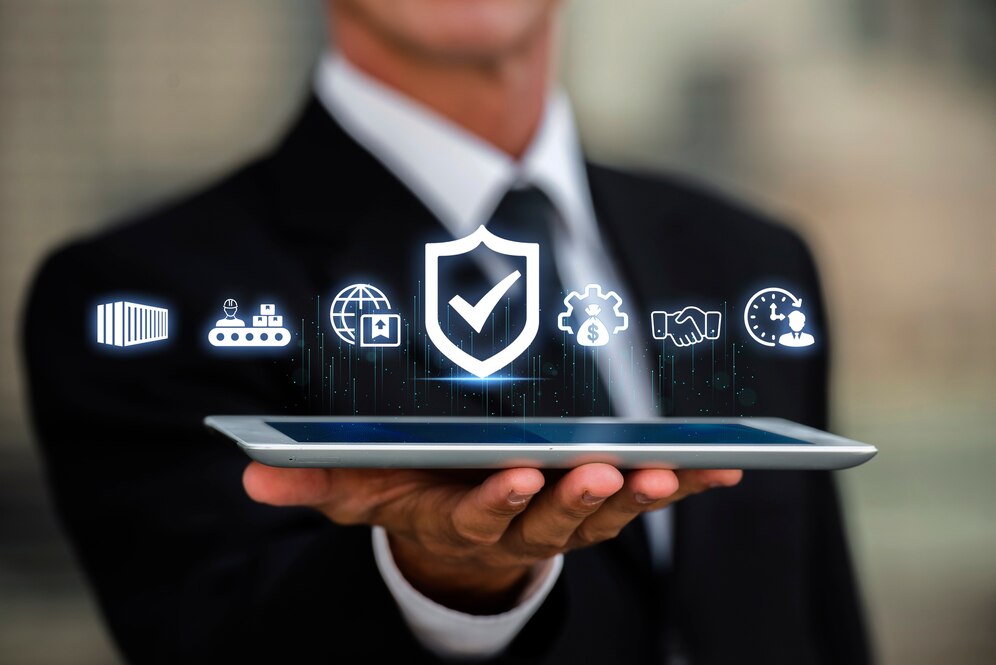
by Huenei IT Services | May 6, 2024 | Cybersecurity, Process & Management
Why Partnering with an ISO 27001 Certified Developer Matters
In the rapidly evolving digital landscape, ensuring the security and reliability of software applications is paramount. As cyber threats continue to escalate, organizations must prioritize implementing robust security measures throughout the software development life cycle (SDLC).
Choosing the right development partner is crucial. This is where certifications like ISO 27001 come in.

The Power of ISO 27001 for Secure Development
This cerfitication provides a comprehensive set of controls and best practices for establishing, implementing, maintaining, and continually improving an Information Security Management System (ISMS). By adhering to this standard, software development organizations can embed security measures into every phase of the SDLC, from requirements gathering and design to coding, testing, and deployment.
“ISO 27001 emphasizes identifying information security risks throughout the entire organization,” explains Jorge Attaguile, COO of Huenei IT Services. “This applies to the Secure Development Life Cycle (SDLC) as well. By implementing a risk-based approach, we can identify and mitigate potential vulnerabilities in the software itself, development processes, and data handling.”
Proper documentation is a cornerstone, and the SDLC is no exception. Documented procedures for secure development cover aspects like security requirements, coding standards, and testing procedures. Additionally, continuous improvement is a core principle. This translates to regularly reviewing and updating SDLC security practices, potentially involving security tools, penetration testing, and adapting to new threats, as Attaguile highlights: “ISO 27001 offers a comprehensive set of controls that can be adapted to specific SDLC and security needs.”
“ISO 27001 requires organizations to establish and apply security rules throughout the SDLC,” explains Dr. Rebecca Herold, a renowned information security expert and CEO of NIST Risk Management. “This can involve secure coding practices, access controls, vulnerability management, and robust testing procedures.”
Complementing ISO 27001 with ITIL processes can further enhance the efficiency and effectiveness of secure software development. ITIL provides a framework for standardizing IT service management practices, focusing on delivering high-quality IT services while aligning with business needs.
“ITIL processes already touch on various security aspects, such as change management, incident management, and problem management,” notes Stuart Rance, an ITIL expert and author of several ITIL publications. “By integrating ISO 27001 controls into these processes, organizations can ensure that security is embedded within their IT service management practices.”
By integrating security controls into existing ITIL workflows, a software development company can achieve a more efficient and secure development process.
In essence, Attaguile continues, “ITIL provides a foundation for efficient service delivery, while ISO 27001 ensures security is built into those processes. Integrating them allows a software development company to achieve both efficient and secure development.”
The Client Advantage
The benefits of partnering with a developer certified are numerous. By implementing ISO 27001 controls within ITIL processes, the development process becomes more secure, resulting in a final product with fewer vulnerabilities and a lower risk of security breaches. Your data and the software itself are better protected.
Furthermore, ITIL’s focus on high-quality IT services, when combined with ISO 27001, ensures security best practices are ingrained within the development lifecycle. This leads to a more robust and reliable final product with fewer bugs and security issues. Additionally, streamlining processes through ITIL and integrating security controls can lead to faster development cycles and potentially lower costs, translating to faster delivery times or more competitive pricing.
As Attaguile concludes, “Knowing a development company adheres to both ISO 27001 and ITIL standards demonstrates a commitment to quality and security. This fosters trust and confidence in our ability to deliver a secure and reliable product that meets your business needs.”
Partnering for Success
By choosing a development partner certified in ISO 27001 and ITIL standards, you gain a significant advantage. You receive a more secure, reliable product delivered efficiently by a trustworthy provider. This translates to peace of mind and a successful software development project.
 Get in Touch!
Get in Touch!
Isabel Rivas
Business Development Representative
irivas@huenei.com

by Huenei IT Services | May 6, 2024 | Software development
Building secure and reliable software is paramount for businesses today, especially when adhering to strict security frameworks like ISO 27001. Traditional approaches to development can be time-consuming, prone to errors, and make it challenging to maintain compliance. Here’s where Generative AI (Gen AI) steps in as a revolutionary force.

Revolutionizing Development with AI-Powered Insights
Traditional development processes often involve manual code reviews and testing, leading to bottlenecks and potential vulnerabilities that can derail ISO 27001 compliance efforts. Gen AI, on the other hand, learns from vast code repositories, identifying patterns, best practices, and potential security weaknesses.
“Generative AI can analyze mountains of code in real-time, highlighting areas that might conflict with ISO 27001 controls and suggesting improvements to align with the standard,” explains Gustavo Commisso, CEO of Huenei IT Services. “This empowers developers to write cleaner, more secure code from the start, reducing the risk of vulnerabilities and simplifying compliance audits.”
AI Streamlines Development Workflows and Maintains Compliance
Beyond security, Gen AI can automate repetitive tasks such as unit testing and code generation, tasks crucial for ISO 27001 compliance. This frees up developers’ time to focus on higher-level problem-solving and innovation, while ensuring adherence to security best practices.
“AI can automatically generate boilerplate code, unit tests, and documentation that meet ISO 27001 requirements,” says Commisso. “This significantly reduces development time and effort while demonstrably strengthening your software’s security posture for audits.”
Continuous Learning: The AI Advantage
A key strength of Gen AI is its ability to continuously learn and adapt. As new code and security threats are encountered, AI models refine themselves, becoming more efficient and effective.
Commisso highlights, “Gen AI aligns perfectly with Agile development methodologies. By continuously learning from new data, AI systems can adapt to changing requirements and security landscapes, ensuring your software remains robust, secure, and compliant with ISO 27001 standards.”
Challenges and Considerations
While the benefits of Gen AI are undeniable, careful planning is crucial. Data quality, model interpretability, and developer training are essential for responsible and effective AI implementation.
“We must remember that AI is a powerful tool, not a silver bullet,” cautions Commisso. “Successful adoption requires a well-defined strategy, collaboration between developers and AI specialists, and ongoing monitoring of the AI models to ensure continued effectiveness and alignment with ISO 27001 controls.”
The future of software development is brimming with possibilities thanks to Gen AI. By integrating it with established development practices and ISO 27001 compliance frameworks, companies can achieve significant gains in efficiency, security, and innovation. This powerful combination empowers developers to build better, more secure software faster, all while demonstrably maintaining compliance with rigorous security standards.
 Get in Touch!
Get in Touch!
Isabel Rivas
Business Development Representative
irivas@huenei.com

by Huenei IT Services | May 6, 2024 | Process & Management
In today’s dynamic tech world, software teams face constant pressure: deliver high-quality applications that meet ever-evolving business needs, all while adapting to new technologies, customer demands, and market shifts. Agility and adaptability are key to success, and that’s where ITIL (Information Technology Infrastructure Library) comes in, particularly its emphasis on continual service improvement (CSI).

What is ITIL Continual Service Improvement?
ITIL, a globally recognized framework for IT service management, offers a structured approach for constantly reviewing and improving processes, tools, and practices within an organization.
“By embracing this principle,” explains Carlos Gómez Galzerano, Project Management Office Manager at Huenei, “software development teams can cultivate a culture of continuous learning and adaptation, positioning themselves for long-term success in this ever-changing technological landscape.”
The core of ITIL’s CSI process is a cyclical model known as Plan-Do-Check-Act (PDCA):
- Plan: Assess your current state and identify areas for improvement.
- Do: Implement the planned changes.
- Check: Monitor the impact of those changes.
- Act: Analyze the results and adapt your approach as needed.
By adopting this mindset, our software teams can proactively address challenges, optimize their workflows, and stay ahead of the curve.
Carlos Gómez Galzerano
Benefits of Continual Service Improvement for Software Teams
One of the key advantages of continual service improvement is its ability to foster a culture of continuous learning and knowledge sharing. ITIL promotes the creation and maintenance of a centralized knowledge base, enabling teams to document best practices, lessons learned, and insights gained from past experiences. This shared repository of information not only facilitates knowledge transfer but also empowers teams to make informed decisions and avoid repeating past mistakes.
Agile methodologies, widely adopted by modern software teams, emphasize iterative development, frequent feedback loops, and the ability to adapt quickly to changing requirements. “By integrating ITIL’s continual improvement processes with agile practices,” Gómez Galzerano remarks, “teams can enhance their ability to respond to evolving business needs and deliver value more efficiently.”
Implementing ITIL’s continual service improvement practices can also foster a culture of collaboration and cross-functional teamwork. By bringing together stakeholders from various disciplines, including development, operations, and support, teams can gain a holistic perspective on their processes and identify opportunities for improvement that may have been overlooked within siloed functional areas.
“By fostering a culture of continuous learning, adaptation, and improvement, we equip our teams with the tools and mindset necessary to deliver high-quality, resilient software solutions that drive business success”, Gómez Galzerano concludes.
 Get in Touch!
Get in Touch!
Francisco Ferrando
Business Development Representative
fferrando@huenei.com

by Huenei IT Services | Apr 8, 2024 | Artificial Intelligence, Software testing
The software industry is a relentless sprint.
Development teams face ever-increasing pressure to deliver high-quality solutions at breakneck speed. Traditional testing methods, however, can be slow and cumbersome, acting as a bottleneck in your agile workflow.
At Huenei, we understand this challenge. That’s why we’ve harnessed the power of Artificial Intelligence (AI) to revolutionize our software testing processes. We can help you do the same.

“AI-powered testing tools have been a game-changer for our teams,” says Alejandra Ochoa, Service Delivery Manager at Huenei. “By automating and optimizing various aspects of the testing lifecycle, we’ve been able to significantly reduce the time and effort required to ensure the quality of our software solutions.”
Accelerating Test Automation with AI
One of the key benefits we’ve experienced is the ability to create airtight automated tests up to five times faster than traditional methods. We leverage advanced algorithms and natural language processing (NLP) capabilities, allowing our developers and testers to write automated tests in plain English. This NLP-based scripting approach simplifies the test authoring process and promotes collaboration among team members with varying technical backgrounds.
“The NLP-based scripting feature has been a game-changer for our agile teams,” Ochoa explains. “Our testers can now focus on testing scenarios and leave the technical implementation details to the AI-powered tools, resulting in more efficient and effective test coverage.”
With this remarkable effort decrease in automatic test case generation, we’re empowered to seamlessly integrate automated testing right from Sprint #1 for all new application developments. Plus, as the Sprints unfold, we can effortlessly expand test coverage, ensuring superior quality and coverage every step of the way. And even more benefits, once the software application has been ended, we have full automated testing coverage!
Streamlining Test Execution and Error Detection
But the benefits don’t stop there. AI-powered testing tools have also optimized test execution, reducing build times from hours to minutes. This efficiency translates into faster feedback loops, allowing our development teams to identify and address issues more promptly, ultimately speeding up the delivery of high-quality software solutions to our clients.
Moreover, these tools excel at identifying and diagnosing functional and visual errors that may have gone unnoticed by human testers. By analyzing vast amounts of data and recognizing patterns, AI-powered testing solutions can catch even the most subtle defects, ensuring a more robust and reliable software product for our clients.
Embracing AI in Agile Testing
At Huenei, we’ve fully embraced the integration of AI in our software testing processes, recognizing its potential to enhance our agile development methodologies. From data-driven testing to cross-platform compatibility testing, AI-powered tools provide comprehensive capabilities that enable our teams to work more efficiently and deliver superior results.
“One of the key advantages of AI in our agile testing processes is the ability to continuously learn and adapt,” Ochoa notes. “As AI-powered tools process more data and encounter new scenarios, they refine their algorithms and improve their testing strategies, resulting in more effective and efficient testing over time.”
Empowering Teams with Intelligent Solutions
At the core of our approach is the belief that AI should empower our teams, not replace them. While AI-powered testing tools automate and optimize many aspects of the testing process, human expertise and oversight remain crucial. We strike a balance between leveraging AI capabilities and ensuring that our developers and testers are actively involved, providing valuable insights and making critical decisions.
“We prioritize responsible and trustworthy AI practices,” Ochoa emphasizes. “Our ethical guidelines and principles ensure that our AI-powered testing tools are developed and deployed with fairness, accountability, and transparency in mind.”
By harnessing the power of AI in our software testing processes, we unlock new levels of efficiency, quality, and agility.

by Huenei IT Services | Apr 8, 2024 | Artificial Intelligence
As technology continues its relentless march forward, we are witnessing the convergence of several truly disruptive innovations – WEB3, the Internet of Things (IoT), Artificial Intelligence (AI), and Blockchain. This powerful intersection is shattering boundaries and unlocking unprecedented opportunities for businesses to thrive in the digital age.

Redefining Digital Ownership with WEB3
At the core of this convergence lies WEB3, the next evolutionary leap for the World Wide Web. WEB3 represents a paradigm shift, decentralizing the web and putting control back into the hands of users through blockchain-based ownership of digital assets and data. This democratization disrupts traditional power dynamics, fostering greater transparency, autonomy, and innovation.
In this new realm, businesses can leverage non-fungible tokens (NFTs) and decentralized applications (dApps) to create unique digital assets and experiences for their customers. From tokenized loyalty programs to immersive virtual worlds, the potential for novel engagement models is staggering. Crucially, WEB3 safeguards user privacy and data sovereignty, fostering trust – the bedrock of lasting customer relationships.
Real-Time Intelligence Fueled by IoT
Complementing WEB3 is the Internet of Things, an interconnected ecosystem of physical devices embedded with sensors and software, collecting and exchanging real-time data. This continuous stream of IoT intelligence provides businesses with unprecedented visibility into their operations, assets, and customer behaviors.
By harnessing IoT data, companies can optimize processes, preempt maintenance issues, and deliver hyper-personalized products and services. The possibilities are vast – from predictive maintenance in manufacturing to precision agriculture and smart city initiatives. And when combined with AI, the insights extracted from this data become even more powerful.
AI: The Intelligence Amplifier
Artificial Intelligence acts as a force multiplier, turbocharging decision-making, automation, and personalization across virtually every industry vertical. As the volume and complexity of data grow, AI’s ability to identify patterns, make predictions, and generate insights becomes indispensable.
From supply chain optimization and dynamic pricing models to chatbots and recommendation engines, AI is already augmenting human capabilities and driving operational efficiencies. As the technology continues to evolve, we can expect to see increasingly sophisticated applications in areas like autonomous systems, computer vision, and generative AI – opening new frontiers for innovation.
Blockchain: The Trust Protocol
Underpinning this convergence is Blockchain, the distributed ledger technology that guarantees secure, transparent, and tamper-proof record-keeping. By decentralizing trust and removing intermediaries, Blockchain streamlines processes, reduces costs, and mitigates risks associated with fraud, cybercrime, and counterfeiting.
In supply chain management, for instance, Blockchain enables comprehensive traceability – from raw materials to finished goods, empowering conscious consumers with complete transparency. In finance, it’s revolutionizing cross-border payments, lending, and trading through decentralized finance (DeFi) platforms. In healthcare, it’s fortifying the integrity of electronic medical records and powering secure data-sharing for collaborative research.
Success Stories from the Convergence Frontier
While still in its nascent stages, the convergence of these technologies is already yielding compelling success stories across diverse sectors:
- In fashion, companies like MVFW are leveraging NFTs and virtual runways to engage younger audiences and monetize digital fashion experiences.
- Automotive giants like BMW are exploring Blockchain to create tamper-proof digital histories for vehicles, enhancing trust and transparency.
- DeFi platforms like Aave are using AI to automate loan origination and risk assessment, driving financial inclusion.
- Agriculture leaders like Haylettee are deploying IoT sensors and Blockchain to optimize crop yields while enabling full supply chain transparency.
The examples are endless, spanning retail, manufacturing, energy, transportation, and beyond. However, these are just the opening salvos – the true potential of this convergence has barely been tapped.
Embracing the Convergence
As these powerful technologies continue intertwining, businesses face an inflection point: they can either embrace the convergence or risk obsolescence. By harnessing WEB3, IoT, AI, and Blockchain in unison, forward-thinking organizations can unlock new revenue streams, forge deeper customer relationships, drive sustainable practices, and future-proof their operations.
The convergence isn’t just a technological revolution – it’s a fundamental reshaping of how businesses create and deliver value. And those who take the leap stand to reap immense competitive advantages in this boundary-less frontier. The future belongs to the bold, the innovative, and those willing to ride the convergence wave into uncharted waters of opportunity.


 Get in Touch!
Get in Touch!

 Get in Touch!
Get in Touch! 
 Get in Touch!
Get in Touch!
